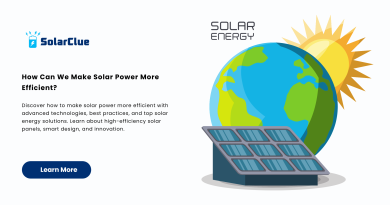Understanding Solar Cell Working: A Comprehensive Guide
Table of Contents
Solar Cell Working: Harnessing the Power of the Sun
With increasing concern over the use of fossil fuels and the impact of greenhouse gas emissions on our planet, renewable energy sources have emerged as a viable and sustainable solution. Solar energy, in particular, has gained significant traction due to its abundance and environmental friendliness. At the heart of this renewable energy revolution lies the solar cell, a device that directly converts sunlight into electrical energy. In this blog, we will delve into the workings of solar cells and the intricate processes that underpin their functionality.
The Basics: How Solar Cells Work
At its core, a solar cell is essentially a semiconductor device that absorbs photons from the sun and converts them into electricity. The most commonly employed semiconductor material in solar cells is silicon, due to its favorable electrical properties. However, several other materials, such as cadmium telluride and gallium arsenide, are also used in specific applications.
Within a solar cell, multiple layers of materials are carefully engineered to achieve the desired electrical characteristics. The topmost layer, called the anti-reflection coating, minimizes the reflection of sunlight and maximizes the absorption of photons. Beneath this layer lies the p-n junction, where the magic of solar energy conversion takes place.
The Photovoltaic Process: Unraveling the Power of Light
The p-n junction, also known as the depletion region, is the crucial part of the solar cell. It is formed by joining a p-type semiconductor (positively charged) with an n-type semiconductor (negatively charged). This junction creates an electric field that separates photogenerated charge carriers, resulting in the generation of a voltage potential.
When sunlight strikes the solar cell, photons with sufficient energy are absorbed by the semiconductor material. This energy is transferred to an electron, promoting it to a higher energy state. The excited electron, now free to move within the material, can be harnessed to generate electricity.
Importantly, the p-n junction ensures that the generated electron-hole pairs, i.e., negatively charged electrons and positively charged holes, are separated. The electric field within the solar cell triggers the migration of the electrons towards the n-type semiconductor and the holes towards the p-type semiconductor.
By incorporating metal contacts on either side of the solar cell, a closed circuit is formed. This allows the flow of electrons from the n-type semiconductor, through an external electrical load, and back to the p-type semiconductor. The resulting current can be used to power various electrical devices.
Realizing the Dream: From Solar Cells to Solar Panels
While a single solar cell is capable of generating only a small amount of electrical power, the real potential lies in the combination of multiple cells into a solar panel. Solar panels are an assembly of numerous interconnected solar cells, which together provide a substantial amount of electricity. These panels are what fuel the growing use of solar energy in homes, businesses, and even in large-scale solar power plants.
It is worth noting that solar cells have come a long way since their inception. Technological advancements have led to the development of different types of solar cells, each with its own unique characteristics and efficiency levels. For instance, monocrystalline silicon cells are known for their high efficiency, whereas thin-film cells offer flexibility and reduced costs.
Conclusion
Power your knowledge with SolarClue®’s comprehensive guide on the working of solar cells. Understand the photovoltaic effect, explore different solar cell types, and grasp the role of the p-n junction. Learn how solar cells adapt to sunlight variations and discover factors influencing efficiency. SolarClue® demystifies advancements like tandem and perovskite solar cells, offering insights into their potential impact on energy conversion. Navigate temperature effects on solar cell performance and adopt maintenance practices for longevity. Trust SolarClue® to guide you in choosing solar panels with optimal efficiency and cost balance, ensuring a knowledgeable and empowered approach to solar energy. Contact us for expert assistance in your solar journey.
Frequently Asked Questions
Solar cells operate on the principle of the photovoltaic effect. When sunlight strikes the solar cell, it excites electrons, generating an electric current as they flow through the cell.
SolarClue® offers comprehensive insights into solar cell types, explaining how technologies like monocrystalline, polycrystalline, and thin-film impact efficiency and performance.
SolarClue® delves into the interaction of photons with semiconductor materials. The semiconductor’s bandgap determines the energy level required to free electrons, facilitating the conversion of sunlight into electricity.
Certainly, SolarClue® elucidates the role of the p-n junction. It creates an electric field, aiding in the separation of charge carriers—electrons and holes—resulting in the generation of electrical current.
SolarClue® explains how solar cells adapt to varying sunlight conditions. Technologies like tracking systems and anti-reflective coatings optimize energy capture by adjusting to intensity and angles.
SolarClue® discusses factors affecting efficiency, such as material quality and design. We guide consumers in choosing solar panels with the ideal balance of efficiency and cost, aligning with their specific needs.
SolarClue® explores cutting-edge advancements like tandem and perovskite solar cells. We discuss their potential to significantly improve energy conversion efficiency and their evolving role in the solar industry.
SolarClue® addresses the impact of temperature on solar cell performance. We recommend measures, such as proper installation and ventilation, to optimize efficiency in varying temperature conditions.
SolarClue® provides insights into the expected lifespan of solar cells and recommends maintenance practices for longevity. Regular cleaning and inspections are crucial for sustaining consistent performance.
Absolutely, SolarClue® explains the role of inverters in solar cell systems. Choosing the right inverter is critical for overall energy efficiency, and we guide consumers in making informed decisions aligned with their system requirements.




